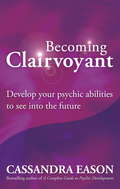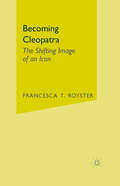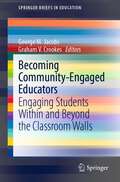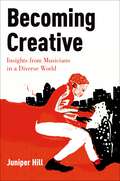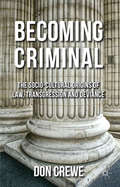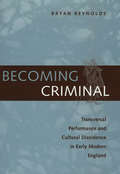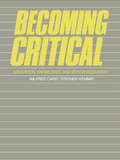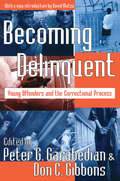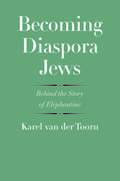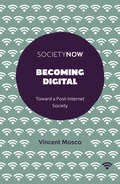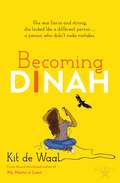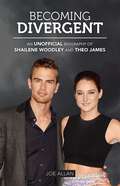- Table View
- List View
Becoming Clairvoyant: Develop your psychic abilities to see into the future
by Cassandra EasonIn BECOMING CLAIRVOYANT, bestselling author and renowned clairvoyant Cassandra Eason will help you to nurture and improve your abilities, and take them to a higher level of expertise. Whether you want to use your powers purely for pleasure, or if you are hoping to work professionally on the psychic circuit, BECOMING CLAIRVOYANT offers:* Guidance on predictions, tarot reading, premonitions, auras, ghosts, spirit guides, crystals and much more* A step-by-step course in the various elements of clairvoyance* Essential information, practical exercises and self-assessment tests * Invaluable tips on dealing with clients and giving readingsWritten for beginners and experts alike, here is a comprehensive and insightful guide to a fascinating line of work.
Becoming Cleopatra: The Shifting Image of an Icon
by F. RoysterCleopatra. Sexy, sultry, political, and racially ambiguous. Moving fluidly from Shakespeare's England to contemporary LA, Francesca Royster looks at the performance of race and sexuality in a wide range of portrayals of that icon of dangerous female sexuality, Cleopatra. Royster begins with Shakespeare's original appropriation of Plutarch, and then moves on to analyze performances of the Cleopatra icon by Josephine Baker, Elizabeth Taylor, Pam Grier (Cleopatra Jones) and Queen Latifah (in Set It Off ). Royster argues that Cleopatra highlights a larger cultural anxiety about women, sexuality, and race.
Becoming Colorado: The Centennial State in 100 Objects
by William WeiCopublished with History Colorado In Becoming Colorado, historian William Wei paints a vivid portrait of Colorado history using 100 of the most compelling artifacts from Colorado’s history. These objects reveal how Colorado has evolved over time, allowing readers to draw multiple connections among periods, places, and people. Collectively, the essays offer a treasure trove of historical insight and unforgettable detail. Beginning with Indigenous people and ending in the early years of the twenty-first century, Wei traces Colorado’s story by taking a close look at unique artifacts that bring to life the cultures and experiences of its people. For each object, a short essay accompanies a full-color photograph. These accessible accounts tell the human stories behind the artifacts, illuminating each object’s importance to the people who used it and its role in forming Colorado’s culture. Together, they show how Colorado was shaped and how Coloradans became the people they are. Theirs is a story of survival, perseverance, enterprise, and luck. Providing a fresh lens through which to view Colorado’s past, Becoming Colorado tells an inclusive story of the Indigenous and the immigrant, the famous and the unknown, the vocal and the voiceless—for they are all Coloradans.
Becoming Community-Engaged Educators: Engaging Students Within and Beyond the Classroom Walls (SpringerBriefs in Education)
by George M. Jacobs Graham V. CrookesThis book puts forth a call to engagement for educators at all levels of education and in all subject areas, with a focus on language education. Through using a grounded theory approach, it features semi-structured interviews, in a qualitative approach, with educators who embody community engaged education. Each chapter encompasses a case study that examines the interviewee's motivations, strategies, successes and failures. This book presents a local theory of community-engaged teachers and researchers to assist educators in developing as a community-engaged teacher or researcher. It asks and attempts to answer critical questions concerning the initial induction into community engagement, the maintenance of energy, commitment, and motivation, and the role of support networks. Through these, this book examines what is needed to sustain such an identity, and support campaigns of action or individual engagement over both the short and long term.
Becoming Creative: Insights from Musicians in a Diverse World
by Juniper HillHow are our ability and motivation to be creative shaped by the world around us? Why does creativity seem to flourish in some environments, while others seem to stifle it? Many societies value creativity as an abstract concept and many, perhaps even most, individuals feel an internal drive to be creative; however, tremendous social pressures restrict individuals' development of creative skill sets, engagement in creative activities, and willingness to take creative risks. Becoming Creative explores how social and cultural factors enable or inhibit creativity in music. Author Juniper Hill integrates perspectives from ethnomusicology, education, sociology, psychology, and performance studies, while prioritizing the voices of practicing musicians and music educators. Insights are drawn from ethnographic research and in-depth interviews with classical, jazz, and traditional musicians in South Africa, Finland, and the US. By comparing and analysing these musicians' personal experiences, Becoming Creative deepens our understanding of the development and practice of musical creativity, the external factors that influence it, and strategies for enhancing it. Hill reveals the common components of how musical creativity is experienced across these cultures and explains why creativity might not always be socially desirable. She identifies ideal creativity-enabling criteria -- specific skills sets, psychological traits and states, and access to opportunities and authority -- and illustrates how these enablers of creativity are fostered or thwarted by a variety of beliefs, attitudes, learning methods, social relationships, institutions, and social inequalities. In addition to theoretical contributions, many sections have direct applications for practice, especially the examination of formal and informal strategies for overcoming inhibitors of creativity. Becoming Creative is for scholars, artists, educators, and anyone wishing to better understand and support creative development in today's world.
BECOMING CREATIVE C: Insights from Musicians in a Diverse World
by Juniper HillHow are our ability and motivation to be creative shaped by the world around us? Why does creativity seem to flourish in some environments, while others seem to stifle it? Many societies value creativity as an abstract concept and many, perhaps even most, individuals feel an internal drive to be creative; however, tremendous social pressures restrict individuals' development of creative skill sets, engagement in creative activities, and willingness to take creative risks. Becoming Creative explores how social and cultural factors enable or inhibit creativity in music. Author Juniper Hill integrates perspectives from ethnomusicology, education, sociology, psychology, and performance studies, while prioritizing the voices of practicing musicians and music educators. Insights are drawn from ethnographic research and in-depth interviews with classical, jazz, and traditional musicians in South Africa, Finland, and the US. By comparing and analysing these musicians' personal experiences, Becoming Creative deepens our understanding of the development and practice of musical creativity, the external factors that influence it, and strategies for enhancing it. Hill reveals the common components of how musical creativity is experienced across these cultures and explains why creativity might not always be socially desirable. She identifies ideal creativity-enabling criteria -- specific skills sets, psychological traits and states, and access to opportunities and authority -- and illustrates how these enablers of creativity are fostered or thwarted by a variety of beliefs, attitudes, learning methods, social relationships, institutions, and social inequalities. In addition to theoretical contributions, many sections have direct applications for practice, especially the examination of formal and informal strategies for overcoming inhibitors of creativity. Becoming Creative is for scholars, artists, educators, and anyone wishing to better understand and support creative development in today's world.
Becoming Criminal: The Socio-Cultural Origins of Law, Transgression, and Deviance
by D. CreweThis book consists of a fundamental deconstruction and reconstruction of the key concepts of Criminology and The Sociology of Law, providing a coherent expression of the relationships between these newly constructed concepts and thus a radically new statement of the relationship between society, crime and the law.
Becoming Criminal: Transversal Performance and Cultural Dissidence in Early Modern England
by Bryan ReynoldsIn this book Bryan Reynolds argues that early modern England experienced a sociocultural phenomenon, unprecedented in English history, which has been largely overlooked by historians and critics. Beginning in the 1520s, a distinct "criminal culture" of beggars, vagabonds, confidence tricksters, prostitutes, and gypsies emerged and flourished. This community defined itself through its criminal conduct and dissident thought and was, in turn,officially defined by and against the dominant conceptions of English cultural normality.Examining plays, popular pamphlets, laws, poems, and scholarly work from the period, Reynolds demonstrates that this criminal culture, though diverse, was united by its own ideology, language, and aesthetic. Using his transversal theory, he shows how the enduring presence of this criminal culture markedly influenced the mainstream culture's aesthetic sensibilities, socioeconomic organization, and systems of belief. He maps the effects of the public theater's transformative force of transversality, such as through the criminality represented by Shakespeare, Jonson, Middleton, and Dekker, on both Elizabethan and Jacobean society and the scholarship devoted to it.
Becoming Critical: Education Knowledge and Action Research
by Wilfred Carr Stephen KemmisFirst published in 1986. Routledge is an imprint of Taylor & Francis, an informa company.
Becoming Critical: Education Knowledge and Action Research
by Wilfred Carr Stephen KemmisFirst published in 1986. Routledge is an imprint of Taylor & Francis, an informa company.
Becoming Critical Teacher Educators: Narratives of Disruption, Possibility, and Praxis
by Julie Ellison Justice F. Blake TenoreThe personal and professional are woven together in this collection of scholarly narratives by teacher educators who share their early critical experiences and model teaching practices to support continued resistance and possibilities in teacher education. Representing myriad contexts where teacher education takes place, the range of scholars included represent diverse racial, gendered, linguistic, economic, and ethnic intersectional perspectives. Each chapter suggests practical tools and encourages readers to reflect on their own journeys of becoming transformational teacher educators. This book adds an important dimension to the field with a new and generative approach to the introduction of critical literacies and pedagogies, and offers a potentially powerful way to explore theory, methodology, and social issues. Readers will enjoy the compelling storytelling of these powerful and vulnerable memoirs.
Becoming Critical Teacher Educators: Narratives of Disruption, Possibility, and Praxis
by Julie Ellison Justice F. Blake TenoreThe personal and professional are woven together in this collection of scholarly narratives by teacher educators who share their early critical experiences and model teaching practices to support continued resistance and possibilities in teacher education. Representing myriad contexts where teacher education takes place, the range of scholars included represent diverse racial, gendered, linguistic, economic, and ethnic intersectional perspectives. Each chapter suggests practical tools and encourages readers to reflect on their own journeys of becoming transformational teacher educators. This book adds an important dimension to the field with a new and generative approach to the introduction of critical literacies and pedagogies, and offers a potentially powerful way to explore theory, methodology, and social issues. Readers will enjoy the compelling storytelling of these powerful and vulnerable memoirs.
Becoming Delinquent: British And European Youth, 1650-1950 (Routledge Revivals)
by Pamela Cox Heather ShoreThis title was first published in 2002: Becoming Delinquent: British and European Youth, 1650-1950 provides a critical synthesis of the growing body of work on the history of British and European juvenile delinquency. It is unique in that it analyzes definitions of and responses to, disorderly youth across time (from the mid-seventeenth to the mid-twentieth centuries) and across space (covering developments across Western Europe). This comparative approach allows it to show how certain themes dominated European discourses of delinquency across this period, not least panics about urban culture, poor parenting, dangerous pleasures, family breakdown, national fitness and future social stability. It also shows how these various threats were countered by recurring strategies, most notably by repeated attempts to deter delinquency, to divide responsibility between the state, civil society and the family, and to find a "proper" balance between moral reform and physical punishment, between care and control.
Becoming Delinquent: Young Offenders and the Correctional Process
by Peter G. Garabedian Don C. GibbonsThis book addresses the social experiences of juvenile offenders in the correctional machinery and the career effects these experiences have on offenders. It follows offenders from apprehension through detention, court appearance, probation and institutionalization, showing how the organizations operate, the role definitions of the people who man them, and the views of the correctional organizations held by members of the public. It is a valuable supplement to courses in deviance, criminology, social problems and organizational analysis. The book begins with the delinquent population and endeavours to identify the major characteristics of juvenile lawbreaking. It separates youths who most often remain as "hidden" delinquents from those who are observed and apprehended. The text then moves through the major parts of the correctional machinery in much the same way as offenders are processed through it. Information on each topic is marshalled in accordance with five dimensions; the nature of the organization; the perspectives of the consumer (the public); the perspective of the employees; the perspectives of the offenders; and the impact of the agency upon offenders. Thus, a major focus of the book is an organizational analysis, a basic feature of the current sociological perspective. This work, on first publication in 1970, was one of the first to tackle the growing skepticism as to the beneficial aspects correctional institutions may have on the young offenders, and the analysis of those benefits. The readings attempt to show something of the impact of correctional experiences on juvenile delinquents, and suggest that the overall effect is to drive deviants further into deviant activities rather than attaining the desired goal of rehabilitation.
Becoming Delinquent: Young Offenders and the Correctional Process
by Peter G. Garabedian Don C. GibbonsThis book addresses the social experiences of juvenile offenders in the correctional machinery and the career effects these experiences have on offenders. It follows offenders from apprehension through detention, court appearance, probation and institutionalization, showing how the organizations operate, the role definitions of the people who man them, and the views of the correctional organizations held by members of the public. It is a valuable supplement to courses in deviance, criminology, social problems and organizational analysis. The book begins with the delinquent population and endeavours to identify the major characteristics of juvenile lawbreaking. It separates youths who most often remain as "hidden" delinquents from those who are observed and apprehended. The text then moves through the major parts of the correctional machinery in much the same way as offenders are processed through it. Information on each topic is marshalled in accordance with five dimensions; the nature of the organization; the perspectives of the consumer (the public); the perspective of the employees; the perspectives of the offenders; and the impact of the agency upon offenders. Thus, a major focus of the book is an organizational analysis, a basic feature of the current sociological perspective. This work, on first publication in 1970, was one of the first to tackle the growing skepticism as to the beneficial aspects correctional institutions may have on the young offenders, and the analysis of those benefits. The readings attempt to show something of the impact of correctional experiences on juvenile delinquents, and suggest that the overall effect is to drive deviants further into deviant activities rather than attaining the desired goal of rehabilitation.
Becoming Delinquent: British and European Youth, 1650–1950 (Routledge Revivals)
by Pamela Cox Heather ShoreThis title was first published in 2002: Becoming Delinquent: British and European Youth, 1650-1950 provides a critical synthesis of the growing body of work on the history of British and European juvenile delinquency. It is unique in that it analyzes definitions of and responses to, disorderly youth across time (from the mid-seventeenth to the mid-twentieth centuries) and across space (covering developments across Western Europe). This comparative approach allows it to show how certain themes dominated European discourses of delinquency across this period, not least panics about urban culture, poor parenting, dangerous pleasures, family breakdown, national fitness and future social stability. It also shows how these various threats were countered by recurring strategies, most notably by repeated attempts to deter delinquency, to divide responsibility between the state, civil society and the family, and to find a "proper" balance between moral reform and physical punishment, between care and control.
Becoming Deviant
by David Matza Thomas G. BlombergBecoming Deviant describes a process by which people move from an affinity for certain prohibited behaviors to full-blown deviance. This process includes affiliation with circles and settings that include or sponsor offenses, followed by understanding and identification of the offenses as prohibited behavior by the transgressor. The process can be summarized as affinity, affiliation, and signification. The sequential process Matza describes allows for non-recurrent offending behavior, recidivism, and offending again. His perspective is motivated by the view that criminological theories do not explain a number of the fundamental empirical features and nuances known to be associated with delinquency. This includes the frequent termination of delinquent behavior at the onset of adulthood, the often conformist nature of delinquent behavior, and the large numbers of non-delinquents that are often found in otherwise "high-delinquency areas." In Becoming Deviant Matza reasons that most, though not all, delinquent behavior constitutes relatively uniform phenomena that is developmental in character. Individuals proceed from trivial to more serious infractions. He argues that delinquent behavior represents youths searching for adventure and is accompanied by withdrawal from conventional values and associated behavior. Matza further claims that many delinquents are not fully committed to a delinquent lifestyle, and this explains why delinquent behavior often ends with adulthood. Matza's compelling and integrated theoretical explanation makes this a classic in the increasingly sophisticated criminological literature. Thomas Blomberg's new introduction shows why Becoming Deviant remains of central importance to the field.
Becoming Deviant
by David Matza Thomas G. BlombergBecoming Deviant describes a process by which people move from an affinity for certain prohibited behaviors to full-blown deviance. This process includes affiliation with circles and settings that include or sponsor offenses, followed by understanding and identification of the offenses as prohibited behavior by the transgressor. The process can be summarized as affinity, affiliation, and signification. The sequential process Matza describes allows for non-recurrent offending behavior, recidivism, and offending again. His perspective is motivated by the view that criminological theories do not explain a number of the fundamental empirical features and nuances known to be associated with delinquency. This includes the frequent termination of delinquent behavior at the onset of adulthood, the often conformist nature of delinquent behavior, and the large numbers of non-delinquents that are often found in otherwise "high-delinquency areas." In Becoming Deviant Matza reasons that most, though not all, delinquent behavior constitutes relatively uniform phenomena that is developmental in character. Individuals proceed from trivial to more serious infractions. He argues that delinquent behavior represents youths searching for adventure and is accompanied by withdrawal from conventional values and associated behavior. Matza further claims that many delinquents are not fully committed to a delinquent lifestyle, and this explains why delinquent behavior often ends with adulthood. Matza's compelling and integrated theoretical explanation makes this a classic in the increasingly sophisticated criminological literature. Thomas Blomberg's new introduction shows why Becoming Deviant remains of central importance to the field.
Becoming Diaspora Jews: Behind the Story of Elephantine (The Anchor Yale Bible Reference Library)
by Karel van ToornBased on a previously unexplored source, this book transforms the way we think about the formation of Jewish identity This book tells the story of the earliest Jewish diaspora in Egypt in a way it has never been told before. In the fifth century BCE there was a Jewish community on Elephantine Island. Why they spoke Aramaic, venerated Aramean gods besides Yaho, and identified as Arameans is a mystery, but a previously little explored papyrus from Egypt sheds new light on their history. The papyrus shows that the ancestors of the Elephantine Jews came originally from Samaria. Due to political circumstances, they left Israel and lived for a century in an Aramean environment. Around 600 BCE, they moved to Egypt. These migrants to Egypt did not claim a Jewish identity when they arrived, but after the destruction of their temple on the island they chose to deploy their Jewish identity to raise sympathy for their cause. Their story—a typical diaspora tale—is not about remaining Jews in the diaspora, but rather about becoming Jews through the diaspora.
Becoming Digital: Toward a Post-Internet Society (SocietyNow)
by Professor Vincent MoscoBecoming Digital examines the transition from the online world we have known to the Next Internet, which is emerging from the convergence of Cloud Computing, Big Data Analytics, and the Internet of Things. The Cloud stores and processes information in data centers; Big Data Analytics provide the tools to analyse and use it; and the Internet of Things connects sensor-equipped devices everywhere to communication networks that span the globe. These technologies make possible a post-Internet society filled with homes that think, machines that make decisions, drones that deliver packages or bombs, and robots that work for us, play with us, and take our jobs. The Next Internet promises a world where computers are everywhere, even inside our bodies, “coming alive” to make possible the unification of people and machines in what some call the Singularity. This timely book explores this potential as both a reality on the horizon and a myth that inspires a new religion of technology. It takes up the coming threats to a democratic, decentralized, and universal Internet and the potential to deepen the problems of commercial saturation, concentrated economic power, cyber-warfare, the erosion of privacy, and environmental degradation. On the other hand, it also shows how the Next Internet can help expand democracy, empowering people worldwide, providing for more of life’s necessities, and advancing social equality. But none of this will happen without concerted political and policy action. Becoming Digital points the way forward.
Becoming Digital: Toward A Post-internet Society (PDF)
by Vincent MoscoBecoming Digital examines the transition from the online world we have known to the Next Internet, which is emerging from the convergence of Cloud Computing, Big Data Analytics, and the Internet of Things. The Cloud stores and processes information in data centers; Big Data Analytics provide the tools to analyse and use it; and the Internet of Things connects sensor-equipped devices everywhere to communication networks that span the globe. These technologies make possible a post-Internet society filled with homes that think, machines that make decisions, drones that deliver packages or bombs, and robots that work for us, play with us, and take our jobs. The Next Internet promises a world where computers are everywhere, even inside our bodies, "coming alive" to make possible the unification of people and machines in what some call the Singularity. This timely book explores this potential as both a reality on the horizon and a myth that inspires a new religion of technology. It takes up the coming threats to a democratic, decentralized, and universal Internet and the potential to deepen the problems of commercial saturation, concentrated economic power, cyber-warfare, the erosion of privacy, and environmental degradation. On the other hand, it also shows how the Next Internet can help expand democracy, empowering people worldwide, providing for more of life's necessities, and advancing social equality. But none of this will happen without concerted political and policy action. Becoming Digital points the way forward.
Becoming Dinah
by Kit de Waal"A gripping, heart-wrenching coming-of-age story" - GuardianIn her first YA novel, Costa-shortlisted Kit de Waal responds to classic Moby Dick by tearing the power away from obsessive Captain Ahab and giving it to a teenage girl.Dinah's whole world is upside down, dead things and angry men and cuts all over her head that are beginning to sting....Seventeen-year-old Dinah needs to leave her home, the weird commune where she grew up. She needs a whole new identity, starting with how she looks, starting with shaving off her hair, her 'crowning glory'. She has to do it quickly, because she has to go now.Dinah was going to go alone and hitch a ride down south. Except, she ends up being persuaded to illegally drive a VW campervan for hundreds of miles, accompanied by a grumpy man with one leg. This wasn't the plan.But while she's driving, Dinah will be forced to confront everything that led her here, everything that will finally show her which direction to turn...In her first YA novel, Costa-shortlisted author Kit de Waal responds to the classic Moby Dick with entirely new characters, a VW campervan, and by tearing the power away from obsessive Captain Ahab and giving it to a teenage girl who's determined to find a new life, far away from her unconventional upbringing."An emotionally charged book" - Daily Mail"Fresh and defiantly original ... what a beautiful book" - Sarah Moore Fitzgerald
Becoming Divergent: An Unofficial Biography of Shailene Woodley and Theo James
by Joe AllanShailene Woodley and Theo James are two stars on the rise. Playing Tris Prior and Tobias 'Four' Eaton respectively, they are set to take Hollywood by storm on the release of Divergent, the fantasy film based on the internationally best-selling novel by Veronica Roth which is set in a futuristic dystopia, produced by the makers of the Twilight Saga.Shailene, best known as Amy Juergens in The Secret Life of the American Teenager and for starring in a Golden Globe-nominated performance alongside George Clooney in The Descendants, has come a long way in a short time. Born to parents employed in education, she worked in an American clothes store while pursuing acting in New York aged 18. Now 21, her television stints, fitted in with schoolwork and paid work over the years, have paid off as she has made the jump to big-budget movie actress.Theo James is a well-educated English actor who has seen increasing success since his appearance as Jed Harper in Bedlam, featuring in The Inbetweeners Movie and Underworld: Awakening, as well as being cast as the lead role in the American crime drama Golden Boy.Both are young actors about to hit the big time, and are sure to gain legions of fans keen to read their stories.
Becoming Donor-Conceived: The Transformation of Anonymity in Gamete Donation (KörperKulturen)
by Amelie BaumannWhile it has been argued that anonymity in gamete donation has been brought to an end by legal changes and technological developments, Amelie Baumann suggests that this is in fact still in transformation. By focusing on the narratives of those who were conceived with anonymously donated gametes in the UK and Germany, she examines this transformative process and the role which donor-conceived persons play in it. This book shows that it is not someone's decision to procreate that turns »being donor-conceived« into a meaningful categorisation. Rather, kinship knowledge gets activated by the donor-conceived in specific ways for »being donor-conceived« to become a powerful identification.
Becoming Dr Bellini's Bride: Becoming Dr Bellini's Bride / Summer Seaside Wedding / Wedding In Darling Downs (Mills And Boon Medical Ser.)
by Joanna NeilPaediatrician Katie Logan moved to the Sunshine State for a fresh start! But her new life is rocked by her dazzling attraction to dreamy doc Nick Bellini, a man she has no reason to trust… Katie tries her best to resist Nick, but if only she'd step into the Italian's strong, tanned arms she just might find her California dreams come true…
